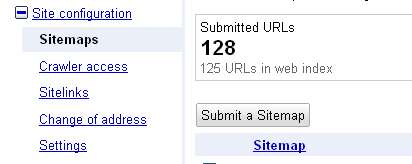 We all know that video is an increasingly important part of SEO, with Google incorporating video results into the search results page and with YouTube currently ranking as the second largest search engine in the world. But much like just building a website isn’t enough to get traffic — just making a video isn’t and tossing it on your site also isn’t enough. You have to optimize your videos for SEO just like you optimize your site and your landing pages.
We all know that video is an increasingly important part of SEO, with Google incorporating video results into the search results page and with YouTube currently ranking as the second largest search engine in the world. But much like just building a website isn’t enough to get traffic — just making a video isn’t and tossing it on your site also isn’t enough. You have to optimize your videos for SEO just like you optimize your site and your landing pages.
One of the tools available to us for video optimization are video XML sitemaps. Unlike standard XML sitemaps, which help your site’s ability to get thoroughly indexed but does not help your actual rankings, video XML sitemaps can actually improve your videos ability to rank in the search results.
The reason for this is that Google and other search engines cannot index video content in the same way they can text. All they know is that a video exists — they need you to tell them what the video is called and what it’s about. With YouTube now moving over to using iframes to embed videos, video sitemaps are more important than ever. Google cannot index the contents of an iframe, so Google may not even know that a video is on your site at all without the sitemap.
Making a video XML sitemap is easy and very similar to standard XML sitemaps, though the process can be time consuming if you have dozens or hundreds of videos.
How to Make a Video XML Sitemap
A video sitemap is just a file that exists on your site for search engines to see. The file is typically named “sitemap-video.xml” and contains information about all of the videos on your entire site (you can also make a single XML video sitemap file that contains all of the information about videos on multiple sites that you control.
Complete instructions on all of the possible elements of the XML video sitemap can be found on the Google support site, however we’ll go over the basics of it here, and a rundown of the required fields, and the optional fields that you should really be using.
A simple video sitemap file for one video might look something like this:
<urlset xmlns=”//www.sitemaps.org/schemas/sitemap/0.9“ ><url><loc>//www.glforge.com/custom-open-die-forgings.html</loc><video:video><video:player_loc allow_embed=”yes“>//www.youtube.com/v/nCw1PKlSEwc</video:player_loc><video:thumbnail_loc>//i.ytimg.com/vi/nCw1PKlSEwc/1.jpg</video:thumbnail_loc><video:title>Custom Open Die Forging</video:title><video:description>A look at the open die forging process, as Great Lakes Forge forges a steel round, and steel rectangle.</video:description><video:duration>127</video:duration><video:category>Forging</video:category><video:tag>forging</video:tag><video:tag>open die forging</video:tag><video:tag>steel forging</video:tag><video:uploader info=”//www.glforge.com/about.html“>Great Lakes Forge</video:uploader></video:video></url>
</urlset>
Video sitemap required fields
- <video:video> – The tag that tells Google this is a video sitemap
- <loc> – Specifies the page on your site where the video is embedded. So if you have a YouTube video on your site, this is the URL of the page on you site, not the page on YouTube
- <video:thumbnail_loc> – this tag gives the URL of the thumbnail image for the video, which should be in JPG or PNG format and be at least 160×120 pixels. This is the thumbnail that will appear in the Google search results, and the nice thing about the tag is that you don’t have to use one of YouTube’s thumbnails — you can create your own and tell Google where to find it with this (required) tag.
- <video:title> – The title of the video.
- <video:description> – Description of the video, which can be up to 2,048 characters.
- <video:content_loc> OR <video:player_loc> – if you are embedding a YouTube or Vimeo video, you should use the player_loc tag to point to the player location. If you are hosting the raw video file on your site (and why would you?) then use the content_loc to point to the video file itself (not the page).
Video sitemap optional fields that you should use
- <video:duration> – The duration of your video, in seconds. This could be displayed in the search results.
- <video:tag> – Think of this as keyword tags for videos, only it isn’t entirely ignored and can help your ranking. You will have to use this tag separately for each keyword phrase, and you cannot include more than 32 per video (though you shouldn’t ever come close to that number. 3-5 should be sufficient, otherwise you’re probably trying to keyword stuff, and Google can sometimes spot that and penalize you for it).
- <video:category> – A one or two word broad and easily recognizable category to help classify your video. Could impact SEO.
- <video:uploader> – Let’s you tell Google who the original uploader of the video is. You can also include a URL in the “info” field (see example above). This URL is supposed to direct to a profile page for the person who uploaded the video, so for most company sites you’ll want to point it to the About Us page.
How to Submit a Video XML Sitemap to Google
Once you’ve created your file and saved it as “sitemap-video.xml” you’ll want to upload it to the root public_html directory of your website. Once it’s there you can submit it to Google through Google Webmaster Tools.
If you don’t have a Webmaster Tools account, you’ll need to set one up (and you should anyway). You can submit a video sitemap via Webmaster tools exactly in the same way as you submit a normal sitemap: from the left menu click on Site Configuration then on Sitemaps. Then click the Submit Sitemap button.
This will give you the option to enter the URL of your sitemap within your domain, and then you’re done! Google now has the sitemap and will soon know a lot more about your video content.
Note that you can and often will have multiple sitemaps submitted through Google Webmaster Tools — one for your site, one for your videos, perhaps one for your blog or however else you have your site segmented.







